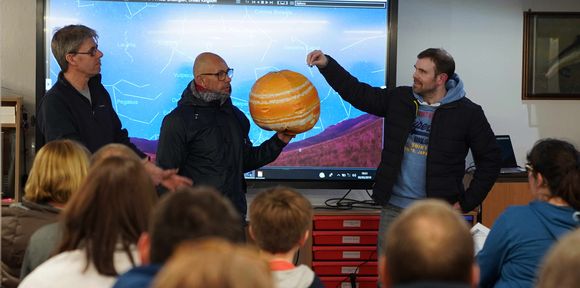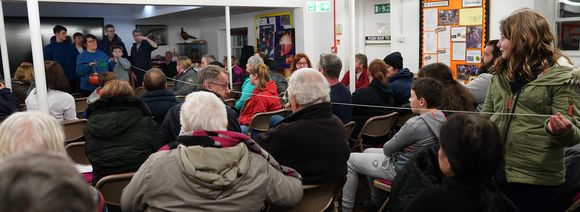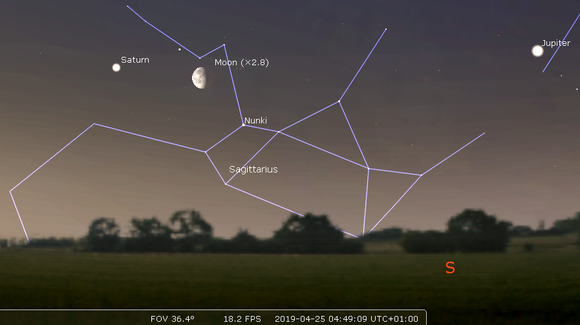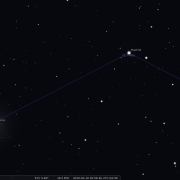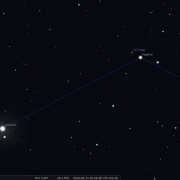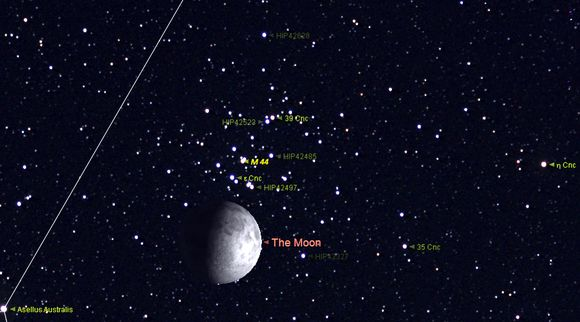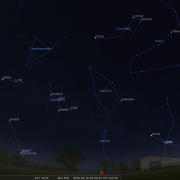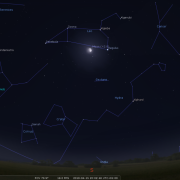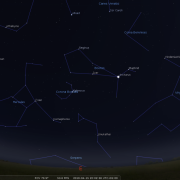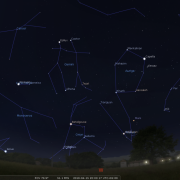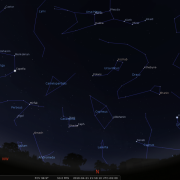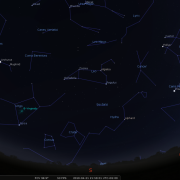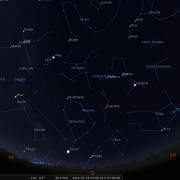
Welcome to the WDAS monthly newsletter for April 2019: a digest of the month's latest contributions to our website. Below you'll find Society News covering March's dark skies events in Fyling Hall (above) and in Danby; up-coming events, news about the observatory refurb and, of course, Sky Notes for the coming month.
Society News
The beginning of March saw two star party events coinciding with the half term ‘dark sky window’, one at Fylinghall School and the other at Danby Moors Centre. After a very fine and unseasonal end to February (almost summer like) it was almost inevitable conditions returned to those normally associated with late winter:- in a word, unpredictable. Observations outdoors was not possible at either event, and yet they could be construed as being successful.
Fylinghall School
For the event hosted on Friday 1st by Fylinghall School, low cloud cover prevented anyone looking through an eyepiece at the night sky. Event organizer, Angelique Russell, greeted us on arrival in the school dining room, where ‘Baytown Coffee’ were serving hot drinks to the gathering crowd.
The school ‘stack yard’ was the venue for our ‘scaled solar system’, which because of the calm conditions was always going to be demonstrated. Using both the ‘planetary scaled string’ and the inflatable planets tied on at the relevant distances, proved both popular and informative for the majority watching on. Further audience participation demonstrated in a very rudimentary fashion the movement of protons within the core of the Sun.
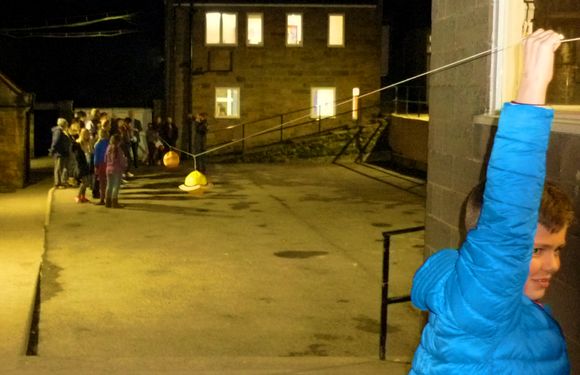
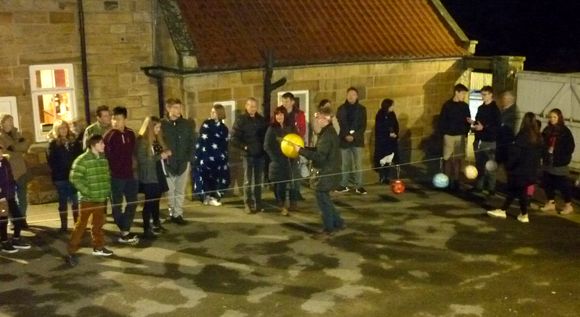
01-Mar-2019 at 21:06h: Scale Solar System demonstration at Fylinghall School
Plan B, and proceedings moved inside to the theatre barn, where after some IT connectivity issues had been sorted, Mark gave a presentation on the various types of deep sky objects astronomers observe. This looked great on the large screen and at least allowed the audience to view in detail some of the objects we had hoped to observe outside. Angelique was rather relieved with the way the evening turned out and had some very positive feedback, from the students and members of the public alike. Suffice to say we will be returning later in the year, hopefully when skies are clear!
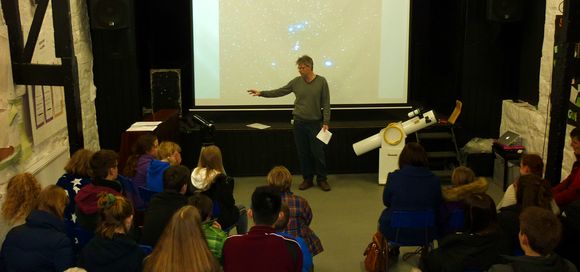
01-Mar-2019 at 21:06h: Mark's Theatre Barn presentation at Fylinghall School
Danby Moors Centre
Another day…and another event, this time at the Danby Moors Centre for the National Parks ‘Dark Sky’ event at that location. The weather had changed somewhat, from quiet, cloudy conditions, to blustery, rainy ones and although the chance of a clearing was forecast for the evening period, it failed to materialize and the loaded scopes were in the main not required.
Greeted once again by Karen Wills- events organiser at the Centre, and Paul Wood, who is also now a WDAS member, we found ourselves indoors - again, the weather not even suitable for demonstrations outside. It felt like déjà vu, all over, with conditions strikingly similar to those experienced at the October Dark sky event.
Time for plan B and C, and after some scaled down, scaled demo’s, in which a number of the 46 strong audience were roped involved, Mark gave a quick tour of the night sky utilising the Starry Night program. Following a tea break, (at which members ably assisted Karen and Co) it was confirmed that observations outdoors were definitely not possible, so Mark gave a presentation on stellar evolution using the ‘winter G’ asterism as the area of reference. It appeared to be well received with positive feedback afterwards.
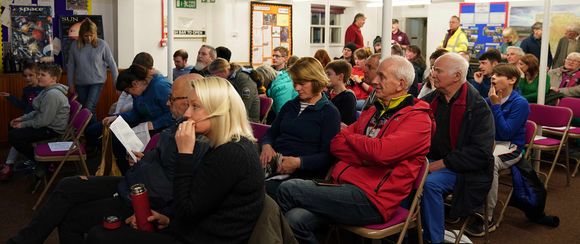
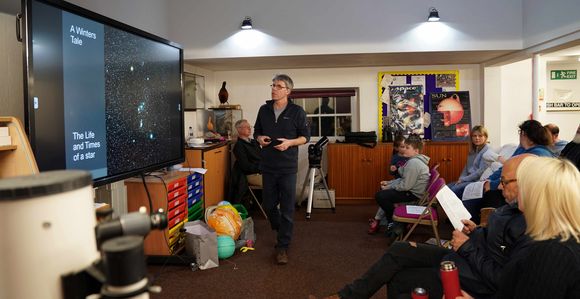
02-Mar-2019 at 20:22h: Danby Event
More or less on time (21:00h) the event ended and as we packed up and reloaded the vehicles, yep, you’ve guessed it, skies cleared and there arrayed in all its glory was our ‘story’ of stellar evolution.... drat it! Oh well, better luck next time.
Many thanks are due to Keith, Barbara and Mark for their assistance on the Friday and Saturday, as well as Andy L, Lee, John R and Paul W for assistance on Saturday, and without who’s help both events would have been impossible.
___
Image Credits (Danby): Keith Deason.
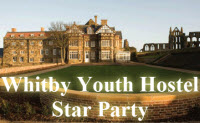 Our association with Ayresome Primary School & Lego Innovation Studio will again be renewed this year after been contacted by Elizabeth Labelle; Assistant Head Teacher (phase3).
Our association with Ayresome Primary School & Lego Innovation Studio will again be renewed this year after been contacted by Elizabeth Labelle; Assistant Head Teacher (phase3).
This year’s group of pupils (around 30 or so) will be stopping at the Whitby Youth Hostel from April 8th - 12th and we shall be hosting a star party event for them on either the 9th, 10th, or 11th, whichever evening according to the forecast looks best. We have hosted these events for the last three years, and according to Libby, the pupils take away so much from the evening. Start time will be around 20:15h on the Abbey visitor centre grassy forecourt area. Mark will be studying the forecasts carefully and will contact members accordingly.
 During our March meeting, it was agreed that the best method of weather proofing the observatory dome and roof was the one put forward by Saul, ie. by applying a new fibre glass surface over coated directly onto the existing felt.
During our March meeting, it was agreed that the best method of weather proofing the observatory dome and roof was the one put forward by Saul, ie. by applying a new fibre glass surface over coated directly onto the existing felt.
Following the generous donation by Norman Wright and perhaps other monies forthcoming from the college, we should have enough funds to carry out the necessary work for the refurbishment.
It has been proposed to start some work during the Easter holidays, with a view to carrying out the work associated with the dome and roof once evenings are light enough to do this.
The work will have to be done in the evening Saul’s time, and weather permitting. Once we know definite dates, assistance may be sought from members to help out; similar to the refurb back in the early 2000’s. We will keep you informed.
And while we're talking of the Whitby Observatory, here are some images taken there of the Moon, during March:
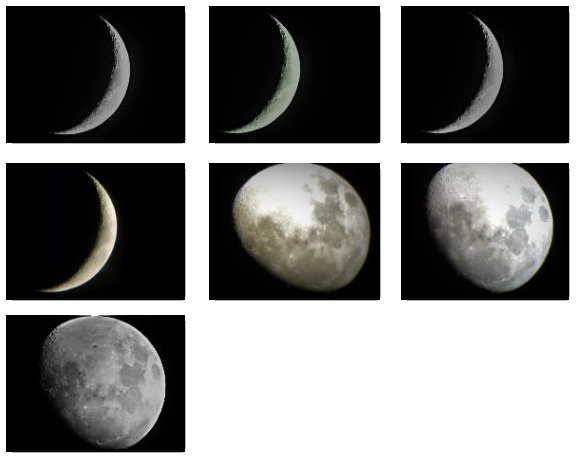
Images of The Moon taken simply with Mark's camera pressed to the telescope lens.
10-Mar-2019: waxing crescent images; 17-Mar-2019: waxing gibbous images.
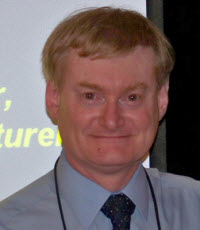 We are currently in the process of booking Paul for a talk, however due to various factors this is most likely to be later in the year rather than May.
We are currently in the process of booking Paul for a talk, however due to various factors this is most likely to be later in the year rather than May.
Information will be posted in the notes or on the website as and when we have some.
Sky Notes
In this month's Sky Notes:
Planetary Skylights
Evening Planets
 Mars is the solitary naked eye planet visible in the evening sky this month, but is now losing its battle with the encroaching twilight. Look for the red planet on the 4th and 5th as it glides up between the Pleiades and the Hyades, highlighted by Aldebaran (the ‘eye of the bull’).
Mars is the solitary naked eye planet visible in the evening sky this month, but is now losing its battle with the encroaching twilight. Look for the red planet on the 4th and 5th as it glides up between the Pleiades and the Hyades, highlighted by Aldebaran (the ‘eye of the bull’).
A waxing crescent Moon lies in proximity on the 9th. Mars continues to move up through Taurus, as the bull descends down toward the WNW horizon, and ends the month almost between the ‘horn stars’; zeta and beta tauri.
Dawn Planets
The early dawn sky is home to the majority of the bright naked eye planets.
 Venus languishes very low to the east horizon and is technically visible all month for less than 30mins before sunrise. Mercury joins it later in the month, but this a very difficult apparition to view.
Venus languishes very low to the east horizon and is technically visible all month for less than 30mins before sunrise. Mercury joins it later in the month, but this a very difficult apparition to view.
Jupiter and Saturn are better placed for observation and dominate the early morning sky, although they are still rather low, residing on the southerly part of the ecliptic visible before sunrise.
 Jupiter is by far the most conspicuous object in the dawn sky and is visible in the east around 02:00h by mid April, lying to the south as morning brightens. Jupiter resides to the right of the ‘Teapot’ asterism in Sagittarius and reaches its stationary point on the 10th, before commencing its retrograde motion against the backdrop of stars.
Jupiter is by far the most conspicuous object in the dawn sky and is visible in the east around 02:00h by mid April, lying to the south as morning brightens. Jupiter resides to the right of the ‘Teapot’ asterism in Sagittarius and reaches its stationary point on the 10th, before commencing its retrograde motion against the backdrop of stars.
Jupiter will continue to brighten reaching mag - 2.45 by the month’s end with a disc size of 43 arc seconds; large enough for a wealth of detail to be revealed even in smaller instruments. The Moon lies close by on the 23rd and 24th.
Jupiter Galilean moon transit or shadow transit dates of interest as follows:
4th and 5th, 11th, 12th, 14th,16th, 19th, 20th 23rd, 27th, 28th and 30th. Events between 03:00-05:30h
The great red spot transits on the disk on the following dates:
11/12th; 13/14th; 18/19th; 23/24th all between 03:00-04:30h.
 Saturn trails Jupiter into the sky by a couple of hours and is considerably less bright, but still conspicuous to the eye. It resides to the left of the ‘teapot’ asterism - pretty low to the horizon, and observations are going to be somewhat compromised due to our atmosphere. Nevertheless if you have a telescope, your patience at the eyepiece will ultimately be rewarded. The moon lies in proximity on the 25th and 26th.
Saturn trails Jupiter into the sky by a couple of hours and is considerably less bright, but still conspicuous to the eye. It resides to the left of the ‘teapot’ asterism - pretty low to the horizon, and observations are going to be somewhat compromised due to our atmosphere. Nevertheless if you have a telescope, your patience at the eyepiece will ultimately be rewarded. The moon lies in proximity on the 25th and 26th.
Pallas at its best
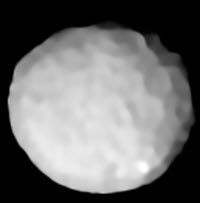
Likely Proto-Planet 'Pallas':
Contains est. 7% of the Asteroid
Belt's mass.
One of the original big four minor planets, Pallas, comes to opposition on the 10/11 April peaking at Magnitude +7.9 and therefore well within the range of binoculars and smaller telescopes.
You can track it down very close to eta Bootis or Muphrid in Bootes on opposition night. With a diameter of over 500km, it is a big old chunk of rock and if you can observe it for any length of time its motion should be perceptible and therefore an exciting prospect.
Moon buzzes the Beehive
If skies are clear on the night of the 13/14th between 21:00-22:00h, turn your binoculars or a smaller telescope towards moon, and you will notice an obvious gathering of faint stars in the background. This is the Beehive cluster (M44) or Praecepe in Cancer and one of the finest spring open clusters.
The Moon does actually occult several stars on the southern fringes of the cluster, and with it occurring in the late evening, it should be a fine sight to view.
13-Apr-2019 at 20:00h: Moon and the Behive Cluster (M44)
Image from Starry Night Pro 8. (Click for full-sized image)
Meteors

A number of lesser meteor showers occur during April.
- The Virginids and alpha Scorpiids each have zenith hourly rates (ZHR) of half a dozen, or so, equating to ‘normal’ sporadic meteor activity levels.
- The Virginids peak on April 7/8th, which is a ‘no moon’ window, therefore increased sightings of Virginids during the early morning hours is more likely.
- The Scorpiids peak on the 27th and will be hampered a little by a waning moon in the early morning hours.
- This month’s most prolific meteor shower; the Lyrids, peak during the early morning hours of the 23rd, but as the moon will be rising after midnight, pre-dawn observations will be compromised somewhat by moonlight. Nevertheless, if you are up and about between 03:00-05:00h, do still keep an eye out for some shooting stars, with upwards of a dozen or so apparent within that period.
April 2019 Sky Charts
|
Looking North
Mid-April - 22:00h |
Looking South |
|
Looking East
Mid-April - 22:00h |
Looking West
Mid-April - 22:00h |
|
Northern Aspect
Mid-April - 21:50h |
Southern Aspect
Mid-April - 21:50h |
| Looking North (Early) Mid-April - 04:30h |
Looking South (Early) Mid-April - 04:30h |
Additional Image Credits:
- Planets and Comets where not otherwise mentioned: NASA
- Sky Charts: Stellarium Software
Events
 Observe the night sky with us at the Bruce Observatory, Whitby School
Observe the night sky with us at the Bruce Observatory, Whitby School
Observing Nights are held weather permitting: check for a relatively clear sky before leaving home. If in doubt, Mark can be reached on 07886069339
Please note the college drive gate is now operated via a electronic key code - so anyone wishing to attend must be at the car park at the top of the drive by 19:00hrs - unless an arrival time has been arranged with Mark/Keith.
 Observe the night sky with us at the Bruce Observatory, Whitby School
Observe the night sky with us at the Bruce Observatory, Whitby School
Observing Nights are held weather permitting: check for a relatively clear sky before leaving home. If in doubt, Mark can be reached on 07886069339
Please note the college drive gate is now operated via a electronic key code - so anyone wishing to attend must be at the car park at the top of the drive by 19:00hrs - unless an arrival time has been arranged with Mark/Keith.
 Whitby School - Room H1.
Whitby School - Room H1.
In Members' monthly meetings we usually take a tour of the night sky for the coming month using the Planetarium program. Have talks and presentations on various topics of astronomy/space etc, and discuss future events etc. New members welcome.
 Observe the night sky with us at the Bruce Observatory, Whitby School
Observe the night sky with us at the Bruce Observatory, Whitby School
Observing Nights are held weather permitting: check for a relatively clear sky before leaving home. If in doubt, Mark can be reached on 07886069339
Please note the college drive gate is now operated via a electronic key code - so anyone wishing to attend must be at the car park at the top of the drive by 19:00hrs - unless an arrival time has been arranged with Mark/Keith.
 Observe the night sky with us at the Bruce Observatory, Whitby School
Observe the night sky with us at the Bruce Observatory, Whitby School
Observing Nights are held weather permitting: check for a relatively clear sky before leaving home. If in doubt, Mark can be reached on 07886069339
Please note the college drive gate is now operated via a electronic key code - so anyone wishing to attend must be at the car park at the top of the drive by 19:00hrs - unless an arrival time has been arranged with Mark/Keith.


